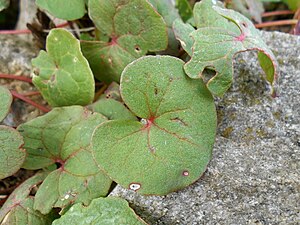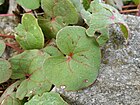Note: This is a project under development. The articles on this wiki are just being initiated and broadly incomplete. You can Help creating new pages.
Difference between revisions of "Oxyria digyna"
| Line 1: | Line 1: | ||
[[File:Oxyria digyna 2017-04-20 8439.jpg|thumb|right]] | [[File:Oxyria digyna 2017-04-20 8439.jpg|thumb|right]] | ||
| + | '''Oxyria digyna''' is a perennial plant that can grow up to 0.45 metres tall. It is harvested from the wild for local use as a food and medicine. | ||
==Uses== | ==Uses== | ||
| − | {{Uses|}}, {{Uses| | + | {{Uses|Scurvy}}, {{Uses|Dysentery}}.<ref name="Uses"/> |
==Parts Used== | ==Parts Used== | ||
| − | {{Parts Used| | + | {{Parts Used|Leaves}}. |
==Chemical Composition== | ==Chemical Composition== | ||
| − | <ref name="chemical composition"/> | + | The structures of three new compounds isolated, from the whole plants of Oxyria digyna (L.) Hill have been elucidated to be oxyriaflavonol (1), 5, 7, 3'-trihydroxy-4-methoxyflavanone-7-O-(2"-O-beta -D-glucopyranosyl)-alpha -L-rhamnopyranoside.<ref name="chemical composition"/> |
==Common names== | ==Common names== | ||
| Line 16: | Line 17: | ||
===Dravya=== | ===Dravya=== | ||
===Rasa=== | ===Rasa=== | ||
| − | |||
===Guna=== | ===Guna=== | ||
| Line 29: | Line 29: | ||
==Habit== | ==Habit== | ||
| − | {{Habit|}} | + | {{Habit|Perennial}} |
==Identification== | ==Identification== | ||
| Line 48: | Line 48: | ||
==Mode of Propagation== | ==Mode of Propagation== | ||
| − | {{Propagation|}} | + | {{Propagation|Seeds}}, {{Propagation|Division in the spring}}. |
==How to plant/cultivate== | ==How to plant/cultivate== | ||
| − | <ref name="How to plant/cultivate"/> | + | Prefers a moist well-drained rocky soil in a sunny position or partial shade.<ref name="How to plant/cultivate"/> |
==Commonly seen growing in areas== | ==Commonly seen growing in areas== | ||
| − | {{Commonly seen|}}, {{Commonly seen|}}, {{Commonly seen| | + | {{Commonly seen|Damp rocky places on mountains}}, {{Commonly seen|Especially by streams}}, {{Commonly seen|On enriched soils below bird roosts}}. |
==Photo Gallery== | ==Photo Gallery== | ||
| Line 67: | Line 67: | ||
<references> | <references> | ||
| − | <ref name="chemical composition">[ | + | <ref name="chemical composition">[https://www.researchgate.net/publication/289264151_Three_New_Compounds_from_Oxyria_digyna_L_Hill Chemistry]</ref> |
| − | <ref name="Leaf">[ | + | <ref name="Leaf">[Morphology]</ref> |
| − | <ref name="How to plant/cultivate">[ | + | <ref name="How to plant/cultivate">[http://temperate.theferns.info/plant/Oxyria+digyna Cultivation]</ref> |
<ref name="Uses">Indian Medicinal Plants by C.P.Khare</ref> | <ref name="Uses">Indian Medicinal Plants by C.P.Khare</ref> | ||
</references> | </references> | ||
==External Links== | ==External Links== | ||
| − | * [ ] | + | * [http://www.flowersofindia.net/catalog/slides/Mountain%20Sorrel.html Oxyria digyna on flowersofindia.net] |
| − | * [ ] | + | * [https://pfaf.org/user/Plant.aspx?LatinName=Oxyria+digyna Oxyria digyna on pfaf.org] |
| − | * [ ] | + | * [http://www.luontoportti.com/suomi/en/kukkakasvit/mountain-sorrel Oxyria digyna on luontoportti.com] |
[[Category:Herbs]] | [[Category:Herbs]] | ||
[[Category:Pages without herbs images]] | [[Category:Pages without herbs images]] | ||
Latest revision as of 13:45, 11 June 2020
Oxyria digyna is a perennial plant that can grow up to 0.45 metres tall. It is harvested from the wild for local use as a food and medicine.
Contents
- 1 Uses
- 2 Parts Used
- 3 Chemical Composition
- 4 Common names
- 5 Properties
- 6 Habit
- 7 Identification
- 8 List of Ayurvedic medicine in which the herb is used
- 9 Where to get the saplings
- 10 Mode of Propagation
- 11 How to plant/cultivate
- 12 Commonly seen growing in areas
- 13 Photo Gallery
- 14 References
- 15 External Links
Uses
Parts Used
Chemical Composition
The structures of three new compounds isolated, from the whole plants of Oxyria digyna (L.) Hill have been elucidated to be oxyriaflavonol (1), 5, 7, 3'-trihydroxy-4-methoxyflavanone-7-O-(2"-O-beta -D-glucopyranosyl)-alpha -L-rhamnopyranoside.[2]
Common names
| Language | Common name |
|---|---|
| Kannada | |
| Hindi | |
| Malayalam | |
| Tamil | |
| Telugu | |
| Marathi | |
| Gujarathi | |
| Punjabi | |
| Kashmiri | |
| Sanskrit | |
| English |
Properties
Reference: Dravya - Substance, Rasa - Taste, Guna - Qualities, Veerya - Potency, Vipaka - Post-digesion effect, Karma - Pharmacological activity, Prabhava - Therepeutics.
Dravya
Rasa
Guna
Veerya
Vipaka
Karma
Prabhava
Habit
Identification
Leaf
| Kind | Shape | Feature |
|---|---|---|
Flower
| Type | Size | Color and composition | Stamen | More information |
|---|---|---|---|---|
| {{{5}}} |
Fruit
| Type | Size | Mass | Appearance | Seeds | More information |
|---|---|---|---|---|---|
Other features
List of Ayurvedic medicine in which the herb is used
Where to get the saplings
Mode of Propagation
Seeds, Division in the spring.
How to plant/cultivate
Prefers a moist well-drained rocky soil in a sunny position or partial shade.[4]
Commonly seen growing in areas
Damp rocky places on mountains, Especially by streams, On enriched soils below bird roosts.
Photo Gallery
References
External Links
- Ayurvedic Herbs known to be helpful to treat Scurvy
- Ayurvedic Herbs known to be helpful to treat Dysentery
- Herbs with Leaves used in medicine
- Habit - Perennial
- Index of Plants which can be propagated by Seeds
- Index of Plants which can be propagated by Division in the spring
- Herbs that are commonly seen in the region of Damp rocky places on mountains
- Herbs that are commonly seen in the region of Especially by streams
- Herbs that are commonly seen in the region of On enriched soils below bird roosts
- Herbs
- Pages without herbs images




